Emmanuel. Temiotan Ogbomida, Chukwudi Nnaemeka Emeribe, Ndubuisi Anthony Itabor
National Centre for Energy and Environment, University of Benin, Benin city
Correspondence to: Chukwudi Nnaemeka Emeribe, National Centre for Energy and Environment, University of Benin, Benin city.
| Email: |  |
Copyright © 2012 Scientific & Academic Publishing. All Rights Reserved.
Abstract
Both Climate change and energy poverty will impact on the collective health, security and economy of Nigeria and make it impossible for the country to attain the MDG Goals. To ensure improved access to energy, while at the same time safeguarding the ecosystem will require energy efficiency initiatives targeted at large-scale implementation of efficient lighting technologies. Compact Fluorescent Lamps (CFLs) are a direct substitute for incandescent light bulbs which is widely used in Nigeria. The paper aims to evaluate the energy and cost savings using compact fluorescent lamps substitute for incandescent light bulbs University campus. The retrofitting exercise lasted for one month between 4pm to 7pm daily. No CFL bulb was given to occupant for personal installation, to ensure that all the points were installed to avert possible reinstallation with incandescent bulbs. Results of post audit evaluation showed that peak loads for the sampled quarters dropped reasonably while energy consumption bills also dropped. In the Professorial quarter money saved is N62,954.58 per month, in A quarter 86% of energy was saved while N224,109.46 money was saved in one month. In B quarter N333,777.45 energy consumption cost was saved in one month. To ensure that the benefits of CFLs are sustained, the study suggests the need for awareness and adequate sensitization of the public on the environmental and economic importance of CFLs through implementation of policies and measures to overcome communication barriers.
Keywords:
Incandescent Bulbs, Compact Fluorescent Lamps (CFLs), Retrofitting, Energy Efficiency, Lighting
Cite this paper: Emmanuel. Temiotan Ogbomida, Chukwudi Nnaemeka Emeribe, Ndubuisi Anthony Itabor, Appraising the Cost and Heat Emission Implications of Residential Energy Efficient Lighting in Benin City, Edo State, International Journal of Energy Engineering, Vol. 3 No. 5, 2013, pp. 234-241. doi: 10.5923/j.ijee.20130305.02.
1. Introduction
The electricity supply–demand gap in less developed countries (LDC) is increasing rapidly as a result of the fast growing demand for electricity to meet socio-economic growth, increasing urbanization, generation capacity deficits, and fuel supply issues. It has been estimated that more than half of the world’s population lives in rural areas, almost 90 percent of them, approximately 3 billion, in developing countries. Out of these, nearly 1.6 billion are without access to energy ([1]; [2]; [3]). As a result, the W1zorld Bank and other regional bodies including ECOWAS have increased its efforts to implement cost-effective supply and demand-side energy efficiency options that will reduce the need for electricity generation and peak capacities ([4]; [5]; [6]). From a lens of demand-side, energy-efficiency measures, energy-efficient lighting technologies offer one of the most promising solutions to help close the supply-demand gap in many developing countries. In these countries, lighting is the most important use of electricity in the domestic sector, and the evening lighting loads contribute significantly to the local electric utility’s peak load ([7]). Although the use of modern, energy-efficient lighting technologies has been increasing over the last several years, particularly in the commercial sector, most of the lighting in the residential sector in developing countries continues to come in the form of traditional incandescent bulbs, which are very energy inefficient when compared to linear fluorescent tube lights (FTLs) and newer lighting technologies such as compact fluorescent lamps (CFL) and light-emitting-diode (LED)-based systems ([7]).From a climate policy perspective, reducing lighting energy consumption by raising the efficacy of lighting systems can be an important means of CO2 abatement. The higher the efficacy, the lower the energy required to deliver a given amount of light, and – depending on the carbon intensity of the electricity generation fuel mix – the lower the greenhouse-gas emissions ([8]).Globally incandescent lamps are estimated to have accounted for 970 TWh of final electricity consumption in 2005 and given rise to about 560 Mt of CO2 emissions. About 61% of this demand was in the residential sector with most of the rest in commercial and public buildings. If current trends continue incandescent lamps could use 1610 TWh of final electricity by 2030 ([8])The Compact Fluorescent Lamps (CFL) with integrated ballast ([9]) was developed as an alternative to the incandescent light bulb specifically for this purpose. CFLs consume a 1/4th to 1/5th of the energy used by incandescent light bulbs to provide the same level of light. About 25% of energy consumed by CFLs is converted to visible light compared with just 5% for a conventional incandescent lamp. CFLs also have much longer lifetimes with rated life spans of 5,000 to 25,000 hours compared to 1,000 hours on average for incandescent lamps ([10]).The efficacy of lighting systems vary significantly from sector to sector, ranging from as low as 20 Lumens/Watt (lm/W) in the residential sector to as high as 80 lm/W in the industrial sector. From a technological perspective, the low efficacy achieved in the residential sector is to a large extent due to the important role of incandescent lamps, which are characterized by very low energy efficiency ([11]).Nigeria faces the complex problems of climate change and energy poverty in form of energy poverty and climate change. It is estimated that currently, 15.3 million households lack access to grid electricity; and for those connected to the national grid, supply is erratic at best. Per capita electricity consumption has been less than 150KWh per annum. Rural areas suffer the most electricity deprivation ([12]). Significant portions of its population and economy are tied to activities that are climate sensitive, such as rainfed agriculture, livestock rearing, fisheries, and forest products extraction. The northern Sahel zone and the heavily populated coastal areas are particularly vulnerable to climate change.Both Climate change and energy poverty will impact on the collective health, security and economy of Nigeria and make it impossible for the country to attain the MDG Goals. To ensure energy access, while at the same time safeguarding the ecosystem will require energy efficiency initiatives targeted at large-scale implementation of efficient lighting technologies. Compact Fluorescent Lamps (CFLs) are a direct substitute for incandescent light bulbs which is widely used in the country. In most developing country including, Nigeria however, there has been low awareness and use of CFLs. Lack of clear incentives to reduce energy consumption and consumers rigid behaviour are often key issues that need to be addressed when deploying CFLs on a large scale ([13]; [14]). The aim of the study is therefore to examine the cost and energy emission implications of retrofitting CFLs in residential quarters within the University of Benin, Nigeria.
2. Research Methodology
2.1. Study area
The study area is University of Benin, Benin City, Edo State. The selected areas were divided into a number of single Project areas including Professorial (P), Senior Staff “A” and “B” quarters of the University of Benin, Ugbowo Campus (Plates. 1-3). Each Project area has boundaries defined by the location of the service transformer.
2.2. Pre-Survey
An on-site survey was conducted for all the residence in the selected quarters. During the survey, a structured questionnaire was administered to the beneficiaries to obtain information on: 1. House types (i.e., single-family detached, single-family attached apartments, etc.)2. Use area or room types (i.e., living room, kitchen, etc.)3. Lighting Energy Audit i.e. incandescent wattages, fixture and bulb types. Energy audit involved consultation with residents to define the retrofitting approach and date and duration of retrofitting exercise. 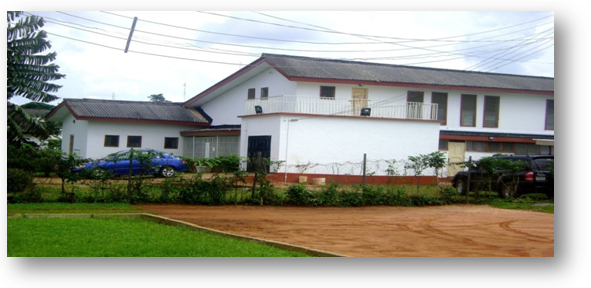 | Plate 1. A Professorial quarter of the Senior Staff quarters of the University of Benin |
 | Plate 2. A typical ‘’A’’ quarters of the Senior Staff quarters of the University of Benin |
 | Plate 3. A typical ‘’B’’ quarters of the Senior Staff quarters of the University of Benin |
Initial information on use area or room types, existing lighting types and number of lighting points were determined using a structured questionnaire. This was complemented with field counts of actual lighting points and types. A total number of 156 questionnaires were administered in the selected quarters, 15 in the Professorial quarter, 51 in ‘’A’’ quarter and 90 in “B” quarters including their Boy’s quarters. The process lasted for four weeks and took place during week days between morning and evening hours to enable full participation of residents.
2.3. Retrieval of Incandescent Bulbs
At the commencement of the project, all the incandescent bulbs were retrieved. These bulbs were taken to the BioEnergy and Environmental Forensic Laboratory, National Centre for Energy and Environmental for analysis and computation of the amounts of energy and billing cost savings.Table 1. Compositions of Quarters and Statistics of Retrieved Incandescent Bulbs
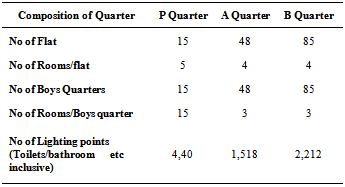 |
| |
|
2.4. Replacement of CLFs
The replacement exercise lasted for one month between 4pm to 7pm daily in order to allow household occupants of full participation. No CFL bulb was given to occupant for personal installation. This is to ensure that all the points were installed to avert possible reinstallation with incandescent bulbs. Effort was made to ensure that replaced CLFs was equal the number of incandescent bulbs retrieved. However there where houses in which retrofitted CFLs were either less or more due to technical reasons resulting from the lighting points.
2.5. Voltage Reading
Average daily voltage usage estimated in each quarters was taken using clamp meter at peak periods when household occupants were at home and all their appliances were switched on. This was done twice daily with readings taken between the hours of 6am and 8pm. Readings were taken from the Professorial, “A” and ‘’B’’ quarters service transformers for two weeks and data on KVA, KWH BILLING were generated using the formulas below:  Where: KVA is “kilo-volts/ampere”V is voltage and I is current
Where: KVA is “kilo-volts/ampere”V is voltage and I is current

2.6. Estimation of Energy Saving
Energy saved was determined using energy smart saving calculator (General Electric Model).
3. Results and Discussion
In Professorial quarter, a total number of a total of 36, 620watts of incandescent bulbs (440) was replaced with 5, 614 watts of CFLs (421) (Figs 1 and 2). The sequence of replacement was 161 60watts incandescent bulbs with 8watts of 96 CFLs, 194 100watts incandescent bulbs with 251 14 watts CFLs and 26 200watts incandescent bulbs with 74 18watts CFLs. After the replacement 31, 006watts of energy was saved in the professorial Quarter giving 85% of energy saved. Calculation of energy saved in ‘’Professorial’’ quarter after replacement of incandescent bulbs with CFLs was 31,006 KWh while money saved was N62, 954.58 in one month (Table 2). 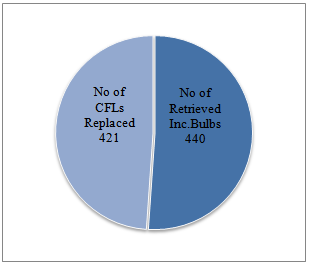 | Figure 1. Variations between No of Inc bulbs replaced with CFLs in Professorial quarter |
 | Figure 2. Variation in energy wattage between CFLs & i ncandescent bulbs in Professorial quarter |
Table 2. Monthly Energy saving in Professorial Quarter
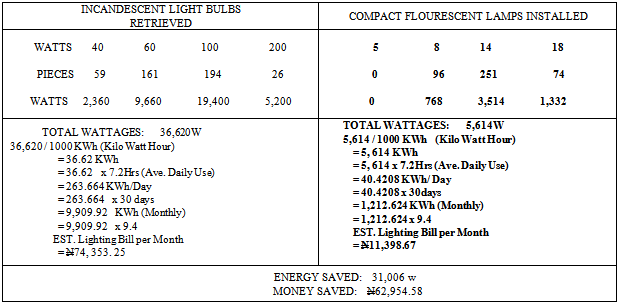 |
| |
|
In “A” quarter, a total of 128,520watts of 1,469 incandescent bulbs was replaced with 18,143watts of 1,518 CFLs in the order of 40watts of 175 incandescent bulbs replaced with 5watts of 137 CFLs, 60 watts of 652 incandescent bulbs with 8 watts 416 of CFLs and 200 watts of 172 incandescent bulbs with 18 watts of 155 CFLs. A total of 110,377watts of energy was saved in the replacement exercise in ‘’A’’ quarter, resulting in N224,109.46 money saved (Figs. 3-4) and Table 3. | Figure 3. variation between no of retrieved Inc. bulbs and replaced CFLs in “A” quarter |
 | Figure 4. Variation in energy wattage between CFLs & incandescent bulbs in “A” quarter |
Table 3. Monthly Energy saving in “A” Quarter
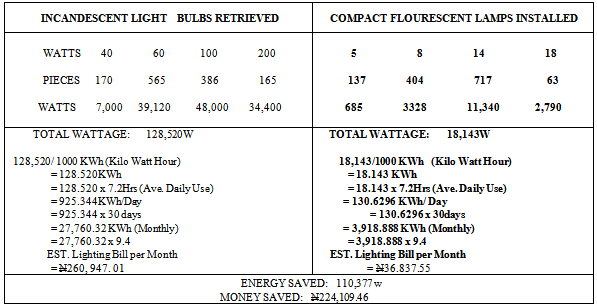 |
| |
|
In ‘’B’’ quarter, a total of 190,880watts of 2,205 incandescent bulbs were replaced with 26,490watts of 2,212 CFLs. 150 of 40watts of incandescent bulbs was replaced with 442 of 5watts of CFLs , 993 of 60 watts was replaced with 200 of 8 watts of CFLs , 871 of 100 watts of incandescent bulbs were replaced with 1,386 of 14 watts of CFLs and 191 of 200 of incandescent bulbs were replaced with 182 of 18 watts of compact fluorescent lamps. A total of 164,390watts was saved in the process while which resulted in N333, 777.45 money saved (Figs 5-6) and (Table 4). | Figure 5. Variation between no of retrieved Inc. bulbs and replaced CFLs in “B” quarter |
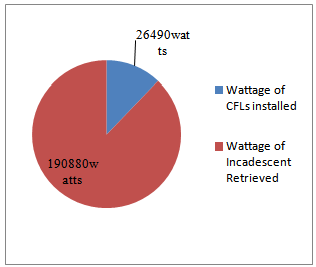 | Figure 6. Variation in energy wattage between CFLs and incandescent bulbs in “B” quarters |
Table 4. Monthly Energy saving in “B” Quarter
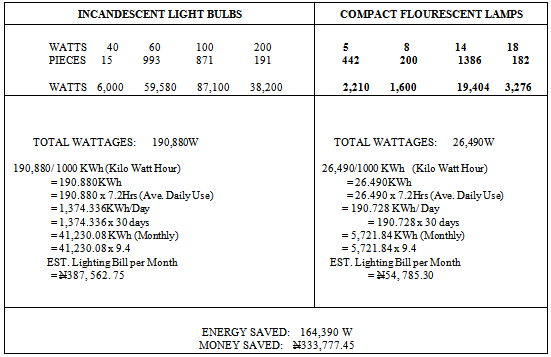 |
| |
|
Figure 7 shows average number of CFLs retrofitted per household. From the figure, it can be observed that the highest numbers of CFLs were installed as security lights at these quarters. This was followed by Living rooms, security post, bedrooms and hallways while the least were installed in the kitchen, bathroom, toilets, stores and garage. | Figure 7. Average number of CFL retrofitted per household Compartments |
 | Figure 8. Variations between Incandescent Bulbs and CFLs wattages |
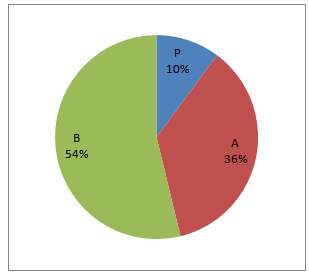 | Figure 9. Percentage Energy saved from respective quarters |
In Figures 8 and 9, variations in energy wattages between the sample quarters and percentage of energy saved are shown. In Fig. 8, highest number of incandescent bulbs prior to retrofitting was highest in “B” quarter followed by “A” quarter. This is corresponded with replaced CFLs and consequently energy saved (Fig. 9). The very high usage of incandescent bulbs in B quarter can be attributed to number housing units in this quarter. More so, “A” and “B” record very high influx of students residents leaving in the Boy’s quarters.
4. Conclusions
Climate change has immediate implications for the sustainability of communities in Nigeria and the health and well-being of individuals and their economies. Creative responses based on sound research, shared knowledge and the engagement of people at all levels is required to meet this critical challenge. There is great potential for minimizing energy wastages and improving residential lighting energy efficiency through the replacement of incandescent bulbs with CFLs. Substituting incandescent lamps with Compact Fluorescent Lamps (CFLs) can thus be an effective means to improve residential sector lighting efficacy since greater percentage of incandescent light bulbs are used at residential sector. More importantly using CFLs in place of has the potentials to reduce system load as shown in the study results.The study showed that tremendous amount of energy was saved while wastages were minimized in the sampled quarters. This reduction was as a result of the replacement of incandescent bulbs with CFLs. To ensure that the benefits of CFLs are sustained, there is need for awareness and adequate sensitization of the public on the environmental and economic importance of CFLs through implementation of policies and measures to overcome communication barriers.
ACKNOWLEDGEMENTS
This project was sponsored by the National Centre for Energy and Environment, an agency of Energy Commission of Nigeria (ECN), University of Benin. The authors would like to acknowledge the support of the DG/CEO Energy Commission of Nigeria, the Cuban Government and ECOWAS for providing the Compact Fluorescent Lamps (CFLs) which were used in this study.
References
| [1] | WEC, 1999, World Energy Council, The Challenge of Rural Energy Poverty in Developing Countries, London: WEC |
| [2] | WEC, 2000, World Energy Council, Energy for Tomorrow’s World – Acting Now, London WEC World Development Indicators (2011): Little Green Data Book 2011. |
| [3] | UN, 2004, United Nations Department of Economic and Social-Affairs Division, World Urbanization Prospects: The 2003 Revision, New York: United Nations |
| [4] | Global Network on Energy for Sustainable Development (GNESD), 2004, Energy Access – Making Power Sector Reform Work for the Poor. Global Network on Energy for Sustainable Development (GNESD), Roskilde, Denmark |
| [5] | Global Network on Energy for Sustainable Development (GNESD), 2005, Political commitment and innovative policies are necessary for power sector reform programmes to benefit the poor, Newsletter (October) |
| [6] | Global Network on Energy for Sustainable Development (GNESD), 2006, Can Renewable Energy make a real contribution? Global Network on Energy for Sustainable Development (GNESD), Newsletter. |
| [7] | Limaye D.R Sarkar A, Singh J., 2009, Large-Scale Residential Energy Efficiency Programs Based on CFLs: The World Bank Report on Energy sector Management Assistance Program (ESMAP), 2009 |
| [8] | IEA, 2006, World Energy Outlook. International Energy Agency (IEA), Paris |
| [9] | Bennet, K., 2001, Energy Efficiency in Africa for Sustainable Development: A South African Perspective, Energy Research Institute, University of Cape Town, South Africa |
| [10] | Banwell, P., Kwartin R., 2006, Quality Assurance in ENERGY STAR Residential Lighting Programmes, presented at the International Energy Efficiency in Domestic Appliances and Lighting Conference, June 2005, London |
| [11] | All China Market Research Co., Ltd. (ACMR), 2004, Survey Report for Annual Follow-up Evaluation of the Promotion Item of China Green Lighting Project, ACMR, Beijing |
| [12] | World Development Indicators, 2011, Little Green Data Book 2011 |
| [13] | Doukas H., Papadopoulou A., Psarras J., Ragwitz M., Schlomann B., 2008, Sustainable Reference Methodology for Energy End-Use Efficiency Data in the EU. Renewable and Sustainable Energy Reviews, 12(8), 2159-2176 |
| [14] | JIN, 2008, Foundation Joint Implementation Network. ENTTRANS, Synthesis report on technology descriptions ‘Sustainable, Low Carbon Technologies for Potential Use under the CDM’, Deliverable 5&6. Paterswolde, FP-6, the Netherlands, |




 Where: KVA is “kilo-volts/ampere”V is voltage and I is current
Where: KVA is “kilo-volts/ampere”V is voltage and I is current










 Abstract
Abstract Reference
Reference Full-Text PDF
Full-Text PDF Full-text HTML
Full-text HTML


